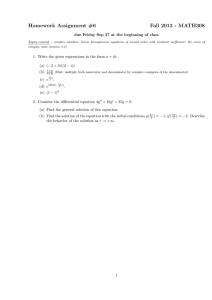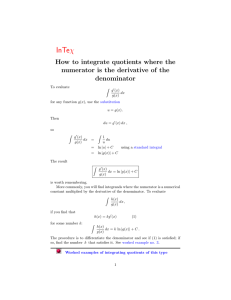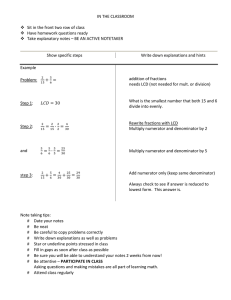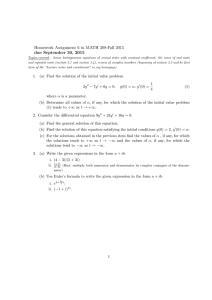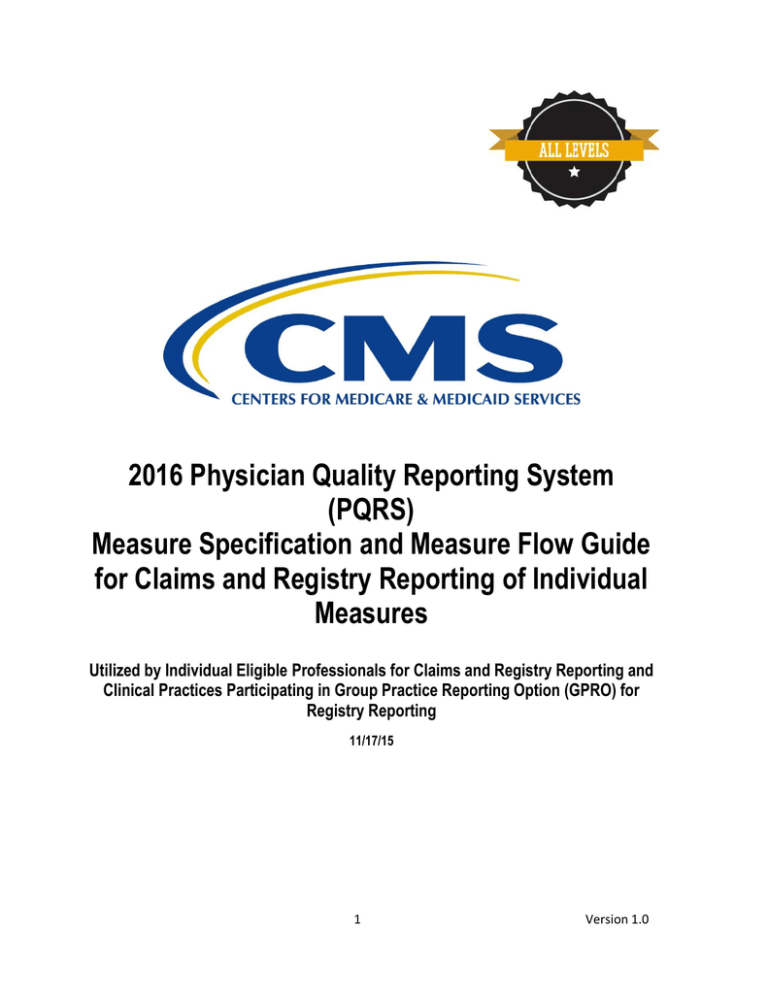
2016 Physician Quality Reporting System
(PQRS)
Measure Specification and Measure Flow Guide
for Claims and Registry Reporting of Individual
Measures
Utilized by Individual Eligible Professionals for Claims and Registry Reporting and
Clinical Practices Participating in Group Practice Reporting Option (GPRO) for
Registry Reporting
11/17/15
1
Version 1.0
Introduction
This document contains general guidance for the 2016 Physician Quality Reporting System (PQRS) Individual
Measure Specifications and Measure Flows for claims and registry reporting. The individual measure specifications
are detailed descriptions of the quality measures and are intended to be utilized by individual eligible professionals
reporting individual measures via claims or registry and by group practices reporting via registry for the 2016
Physician Quality Reporting System (PQRS). In addition, each measure specification document includes a
measure flow and associated algorithm as a resource for the application of logic for reporting and performance.
Please note that the measure flows were created by CMS and may or may not have been reviewed by the
Measure Steward. These diagrams should not be used in place of the measure specification but may be used as
an additional resource.
Reporting Mechanism for Individual Measures to Avoid the 2018 Negative Payment Adjustment
Report on at least 9 individual measures covering 3 National Quality Strategy (NQS) domains for at least 50% of
denominator eligible Medicare Part B FFS patients.
Individual eligible professionals (EPs) (and group practices for registry reporting) that submit
quality data for only 1 to 8 PQRS measures covering 3 NQS domains for at least 50% of the
individual EP’s denominator eligible Medicare Part B FFS patients OR that submit data for 9 or
more PQRS measures covering less than 3 domains for at least 50% of the individual EP’s
Medicare Part B FFS patients eligible for each measure will be subject to Measure-Applicability
Validation (MAV). (See 2016 PQRS Measure Applicability Validation (MAV) Process for Claims
and Registry-Based Reporting of Individual Measures within CMS Analysis and Payment Guide)
Measures with a 0% performance rate will not be counted
An EP that sees at least 1 Medicare patient in a face-to-face encounter must report a minimum of
1 cross-cutting measure. (See 2016 PQRS List of Face-To-Face Encounter Codes within PQRS
Measures Codes)
The PQRS Individual Measure Specifications for Claims and Registry Reporting may not be utilized for other
reporting mechanisms. Below outlines which measure specifications can be utilized for the other reporting
mechanisms and where they can be found. Qualified Clinical Data Registries (QCDRs) can utilize the PQRS
Individual Measure Specifications for Claims and Registry Reporting as well as other measure specifications
outlined below.
Measure specifications for measures groups reporting are included in a separate manual, “2016 Physician
Quality Reporting System Measures Groups Specifications Manual,” which can be accessed at: PQRS
Measures Codes
Group practices electing to participate in the PQRS group practice reporting option (GPRO) reporting
PQRS via GPRO Web-Interface may access the GPRO Web Interface Narrative Specifications and
supporting documents at: GPRO Web Interface
Measure specifications for electronic health record (EHR) based reporting should access the electronic
clinical quality measures (eCQMs) at: CMS Clinical Quality Measures Basics
Information regarding CG-CAHPS may be found at: CAPHS Survey Information (Please note that this link
is directed to the Accredited Care Organization webpage.)
2
Version 1.0
PQRS Individual Measure Specifications
Each measure is assigned a unique number. Measure numbers for 2016 PQRS represents a continuation in
numbering from the 2015 measures. For 2016 PQRS measures that are continuing forward in the 2016 PQRS,
measure specifications have been updated. In addition to the individual measure specifications documents and this
guide, please refer to the “2016 Physician Quality Reporting System Implementation Guide” for additional
information essential in assisting eligible professionals’ understanding and submission of measures. This document
can be accessed at: PQRS Measures Codes.
Eligible Professionals
Eligible professionals submitting billable services on Part B claims for allowable Medicare Physician Fee Schedule
(PFS) charges may report the quality action for selected PQRS quality measure(s). Providers not defined as
eligible professionals are not eligible to participate in PQRS. A list of eligible professionals can be found on the
PQRS website at: How to Get Started with PQRS.
Frequency and Performance Timeframes
The measure instructions limit the frequency of reporting necessary in certain circumstances, such as for patients
with chronic illness for whom a particular process of care is provided only periodically. Each individual eligible
professional or group practices participating in 2016 PQRS should report according to the frequency and timeframe
listed within each measure specification.
Denominator Codes (Eligible Cases) and Numerator Quality-Data Codes
Quality measures consist of a numerator and a denominator that permit the calculation of the percentage of a
defined patient population that receive a particular process of care or achieve a particular outcome. The
denominator population may be defined by demographic information, certain International Classification of
Diseases, Tenth Revision, Clinical Modification (ICD-10-CM) diagnosis, Current Procedural Terminology (CPT) and
Healthcare Common Procedure Coding System (HCPCS) codes specified in the measure that are submitted by
individual eligible professionals as part of a claim for covered services under the PFS for claims-based
reporting. This same criterion is also applied for individual eligible professionals and group practices that chose to
report via a registry although this data is not necessarily submitted via a claim.
If the specified denominator codes for a measure are not included on the patient’s claim (for the same date of
service) as submitted by the individual eligible professional, then the patient does not fall into the denominator
population, and the PQRS measure does not apply to the patient. Likewise, if the specified denominator codes for
a measure are not associated with a patient for an individual eligible professional or group practice submitting to a
registry, then the patient does not fall into the denominator population, and the PQRS measure does not apply to
the patient. Some measure specifications are adapted as needed for implementation in PQRS in agreement with
the measure steward. For example, CPT codes for non-covered services such as preventive visits are not included
in the denominator.
PQRS measure specifications include specific instructions regarding CPT Category I modifiers, place of service
codes, and other detailed information. Each eligible professional and group practice should carefully review the
measure’s denominator coding to determine whether codes submitted on a given claim or to a registry meet
denominator inclusion criteria.
If the patient does fall into the denominator population, the applicable Quality Data Codes or QDCs (CPT Category
II codes or G-codes) that define the numerator should be submitted to satisfactorily report quality data for a
measure for claims based reporting. When a patient falls into the denominator, but the measure specifications
define circumstances in which a patient may be appropriately excluded, CPT Category II code modifiers such as
1P, 2P and 3P or quality-data codes are available to describe medical, patient, system, or other reasons for
performance exclusion. When the performance exclusion does not apply, a measure-specific CPT Category II
reporting modifier 8P or quality-data code may be used to indicate that the process of care was not provided for a
3
Version 1.0
reason not otherwise specified. Each measure specification provides detailed Numerator Options for reporting on
the quality action described by the measure. Although a registry may or may not utilize these same QDCs, the
numerator clinical concepts described for each measure are to be followed when submitting to a registry.
G-codes that are associated with billable charges and found within the denominator, within this reporting program,
are referred to as HCPCS coding. G-codes that describe clinical outcomes or results and are found within the
denominator or numerator are described as QDC’s.
For eligible professionals reporting individually, PQRS measures (including patient-level measure[s]) may be
reported for the same patient by multiple eligible professionals practicing under the same Tax Identification Number
(TIN). If a patient sees multiple providers during the reporting period, that patient can be counted for each individual
NPI reporting if the patient encounter(s) meet denominator inclusion. The following is an example of two provider
NPIs (National Provider Identifiers), billing under the same TIN who are intending to report PQRS Measure #6:
Coronary Artery Disease (CAD): Antiplatelet Therapy. Provider A sees a patient on February 2, 2016 and
prescribes an aspirin and reports the appropriate quality-data code (QDC) for measure #6. Provider B sees the
same patient at an encounter on July 16, 2016 and verifies that the patient has been prescribed and is currently
taking an aspirin. Provider B must also report the appropriate QDCs for the patient at the July encounter to receive
credit for reporting measure #6.
Eligible professionals reporting under a group practice selecting to participate in the PQRS group practice reporting
option (GPRO) under the same Tax Identification Number (TIN), should be reporting on the same patient, when
instructed within the chosen measure. For example, if reporting measure #130: Documentation of Current
Medications in the Medical Record all eligible professionals under the same TIN would report each denominator
eligible instance as instructed by this measure.
If the group practice choses a measure that is required to be reported once per reporting period, then this measure
should be reported at least once during the measure period by at least one eligible professional under the TIN.
Measure #6: Coronary Artery Disease (CAD): Antiplatelet Therapy is an example of a measure that would be
reported once per reporting period under the TIN.
CMS recommends review of any measures that an individual eligible professional or group practice intend to
report. Below is an example measure specification that will assist with satisfactorily reporting. For additional
assistance please contact the QualityNet Help Desk at the following:
QualityNet Help Desk – Available Monday – Friday; 7:00 AM–7:00 PM CST
Phone: 1-866-288-8912
Email: Qnetsupport@hcqis.org
Measure Specification Format (Refer to the Example Measure Specification Below)
Measure title and domain
Reporting option available for each measure (claims-based and/or registry)
Measure description
Instructions on reporting including frequency, timeframes, and applicability
Denominator statement and coding
Numerator statement and coding options
Definition(s) of terms where applicable
Rationale statement for measure
Clinical recommendations or evidence forming the basis for supporting criteria for the measure
The Rationale and Clinical Recommendation Statements sections provide limited supporting information regarding
the quality actions described in the measure. Please contact the measure owner for section references and further
information regarding the clinical rational and recommendations for the described quality action. Measure owner
4
Version 1.0
contact information is located on the last page of the Measures List document, which can be accessed at: PQRS
Measures Codes.
CPT only copyright 2015 American Medical Association. All rights reserved. CPT is a registered trademark of the
American Medical Association. Applicable FARS/DFARS Apply to Government Use. Fee schedules, relative value
units, conversion factors and/or related components are not assigned by the AMA, are not part of CPT, and the
AMA is not recommending their use. The AMA does not directly or indirectly practice medicine or dispense medical
services. The AMA assumes no liability for data contained or not contained herein.
5
Version 1.0
Example Individual Measure Specification:
6
Version 1.0
7
Version 1.0
8
Version 1.0
9
Version 1.0
Interpretation of Individual Measure Flows
Denominator
The Individual Measure Flows are designed to provide interpretation of the measure logic and calculation
methodology for reporting and performance rates. The flows start with the identification of the patient population
(denominator) for the applicable measure’s quality action (numerator). When determining the denominator for all
measures, please remember to include only Medicare Part B FFS patients and CPT I Categories without modifiers
80, 81, 82, AS or TC.
Below is an illustration of additional prerequisite denominator criteria to obtain the patient sample for all
2016 PQRS Individual Measures:
10
Version 1.0
The Individual Measure Flows continue with the appropriate age group and denominator population for the measure.
The Eligible Population box equates to the letter “d” by the patient population that meets the measures inclusion
requirements. Below is an example of the denominator criteria used to determine the eligible population for PQRS #6
NQF # 0067: Coronary Artery Disease (CAD): Antiplatelet Therapy:
11
Version 1.0
Some measures, such as Measure #5 Heart Failure (HF): Angiotensin-Converting Enzyme (ACE) Inhibitor or
Angiotensin Receptor Blocker (ARB) Therapy for Left Ventricular Systolic Dysfunction (LVSD), have multiple options to
determine the measure denominator. Patients meeting the criteria for either denominator option are included as part of
the eligible population.
12
Version 1.0
Numerator
Once the denominator is identified, the flow illustrates and stratifies the quality action (numerator) for reporting
satisfactorily. Depending on the measure being reported, there are several outcomes that may be applicable for
reporting the measures outcome: Performance Met = “a”/green, Performance Exclusion = “b”/yellow, Performance Not
Met = “c”/gray, and Not Reported = red box. On the flow, these outcomes are color-coded and labeled to identify the
particular outcome of the measure represented. This is illustrated below for PQRS #6 NQF # 0067: Coronary Artery
Disease (CAD): Antiplatelet Therapy:
13
Version 1.0
Denominator/Numerator Variation of Claims-Based vs. Registry-Based Reporting
For some measures reportable via claims and registry, two Individual Measure Flows may be included. The
denominator for the registry-based Individual Measure Flow may differ slightly from the denominator as outlined in
the 2016 PQRS Measure Specifications Manual for Claims and Registry Reporting of Individual Measures. Some
measures, such as Measure #19, have a clarifying code and/or language (e.g. G-code G8397 for Measure #19) in
the numerator to identify eligible patients when no CPT I or ICD-10 diagnosis code exists. In the case of Measure
#19, an applicable CPT I code does not exist for Dilated macular or fundus exam performed, including documentation
of the presence or absence of macular edema AND level of severity of retinopathy. In claims-based reporting, an
eligible professional would report the numerator code G8397 to identify patients who had a dilated macular or fundus
exam with documentation of the results. To comply with the measure developer’s intent of the measures and since
registries may not necessarily be reliant on claims data; the flow shows these numerator codes in the denominator.
Therefore the numerator quality-data code options for registry-based flows may vary from the 2016 PQRS Measure
Specifications Manual for Claims and Registry Reporting of Individual Measures.
Reporting and Performance Algorithms
Reporting Algorithm
The Reporting Algorithm is based on the eligible population and sample outcomes of the possible quality actions as
described in the flow of the measure. Avoiding the 2018 PQRS Payment Adjustment is based on reporting
satisfactorily for PQRS by reporting on at least 50% of the eligible patients for the measure. The Reporting Algorithm
provides the calculation logic for patients who have been reported in the eligible professionals’ appropriate
denominator. Reporting satisfactorily may include the following categories provided in the numerator: Performance
Met, Performance Exclusion, and Performance Not Met. Below is a sample reporting rate algorithm for Measure #6.
In the example, 8 patients met the denominator criteria for eligibility, where 4 patients had the quality action
performed (Performance Met), 1 patient did not receive the quality action for a documented reason (Performance
Exclusion), and 2 patients were reported as not receiving the quality action (Performance Not Met). Note: In the
example, 1 patient was eligible for the measure but was not reported (Reporting Not Met).
Reporting Rate=
Performance Met (a=4 patients) + Performance Exclusion (b1+b2+b3=1 patients) + Performance Not Met (c=2 patients) = 7 patients = 87.50%
Eligible Population / Denominator (d=8 patients)
= 8 patients
Performance Algorithm
The Performance Algorithm calculation is based on only those patients that were reported for the measure. For those
patients reported, the numerator is determined by completing the quality action as indicated by Performance Met.
Meeting the quality action for a patient, as indicated in the Individual Measure Specifications Manual, would add one
patient to the denominator and one to the numerator. Patients reporting with Performance Exclusions are subtracted
from the performance denominator when calculating the performance rate percentage. Below is a sample
performance rate algorithm that represents this calculation for Measure #6. In this scenario, the patient sample
equals 7 patients where 4 of these patients had the quality action performed (Performance Met) and one patient was
reported as having a Performance Exclusion.
Performance Rate=
Performance Met (a=4 patients) =
Reporting Numerator (7 patients) – Performance Exclusion (b1+b2+b3=1 patient) =
4 patients = 66.67%
6 patients
For measures with inverse performance rates, such as Measure #1 Diabetes: Hemoglobin A1c Poor Control, a lower
rate indicates better performance. Reporting the Performance Not Met is actually the clinically recommended
outcome or quality action.
There are some measures that require the calculation of multiple performance rates. The Individual Measure Flow for
these measures includes algorithm examples to understand the different reporting and performance rates required
for the measure. Please note, only the performance rates outlined in the measure specification are to be submitted
14
Version 1.0
for registry submissions. The PQRS system will calculate an overall performance rate for the measure if none is
specified within the measure.
Measure Analytical Reporting Frequency Definitions
Analytical reporting frequency labels are provided for each measure. The analytical reporting frequency defines the
time period or event in which the measure should be reported. Below are definitions of the analytical reporting
frequencies that are utilized for calculations of the individual measures:
•
•
•
•
•
•
Patient-intermediate measures are reported a minimum of once per patient during the reporting period. The most
recent quality-data code will be used, if the measure is reported more than once.
Patient-process measures are reported a minimum of once per patient during the reporting period. The most
advantageous quality-data code will be used if the measure is reported more than once.
Patient-periodic measures are reported a minimum of once per patient per timeframe specified by the measure
during the reporting period. The most advantageous quality-data code will be used if the measure is reported
more than once. If more than one quality-data code is reported during the episode time period, performance
rates shall be calculated by the most advantageous quality-data code.
Episode measures are reported once for each occurrence of a particular illness or condition during the reporting
period.
Procedure measures are reported each time a procedure is performed during the reporting period.
Visit measures are reported each time a patient is seen by the individual eligible professional during the
reporting period.
15
Version 1.0

